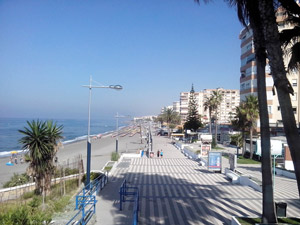0034 686009408
info@villasolrealestate.com


The Torrox stream, which the villagers also call Patalamara, La Plata or Argentino, crosses the municipality from north to south and its waters are used to the full for irrigation before they empty into the sea at Punta de Torrox. The municipality has nine kilometres of sandy beaches along which lie the districts of Torrox Costa, El Morche, Penoncillo and Calaceite.
Torrox, sun and beach all year long, thanks to its pleasant temperature throughout the 12 months of the year, it is for this reason that that this town has received the title, " Torrox , the best climate in Europe".
A bandera azul beach with a wide promenade. This is a semi urban, very busy beach. Its sand is black gravel, It is about 4,300 m long and 20 m wide.
Beach bars, restaurants ice cream parlours shops Showers, sunbeds, umbrellas and public phones Dustbins, beach cleaners Parking Disabled Access Security: danger signs, Red Cross station, life guards.

In Torrox Costa, facing the sea on the right-hand side of the Torrox lighthouse. El Penoncillo beach runs parallel to the old N-340 coastal road and is about 1,400 metres long and, on average, about 20 metres wide. There is a street market on a Monday, with over 40 stalls, from 8am until 2pm. Crafts Torrox a white village in Andalusia. Every Saturday there is a arts and crafts market in the Plaza de la Constitucion in Torrox Malaga. Here you can buy products typical for the area, leather bags, ceramics, flamenco dresses.
Torrox is a town of many festivals and rooted traditions celebrated throughout the year. From the austere and moving Semana Santa to the very famous Fiesta de las Migas (celebrated on the Sunday before Christmas day).
Fiesta of the Tourist is in September, in TORROX, In Homage to the thousands of tourists, national and international that choose Torrox to spend their summer. The traditional meal, "Las Migas", is served at the Ferrara beach. Also other traditional meals such as the arriera salad, charcoal grilled sardines and drinks are handed out.
Most of these ruins are located in the area of the lighthouse of Torrox Costa. Caviclum was a Roman city of the province Betica (Baetica) in Hispania, located which we currently know as the area Torrox Costa (Malaga). In this area you can visit the ruins of this former Roman city, such as the Roman baths, a pottery, a salted-fish factory and the village itself. These ruins date back from the first - fourth century A.D., based on the analysis of Mosaics found in this area.
The Roman village is located inside the lighthouse precinct where some of the walls of the rooms are still standing in this possibly private houses area. Although the materials employed to the construction were not lavish, ornamentation helped to giva a more luxurious appearance. All the rooms had mosaics, some of which are now preserved in the Archaeological Museum of Malaga. At the archaeological area of Torrox you can still see some small pieces of mosaic and fragments of plastered wall with a decorative red line. All the rooms are placed around the atrium, which is a small bowl which they used to collect rainwater. The villa dates from the 3rd century A.D.

Torrox Pueblo, Torrox Pueblo and Torrox Park are three separate areas that overall come under the general description of Torrox.
Torrox Pueblo is one of the Andalucian white villages and is a small way inland from the coastal village of Torrox Costa.
The Pueblo is typical Spanish with winding narrow streets centred around the main plaza where there is a nice choice of bars and restaurants.
Torrox Costa as the name suggests is on the coast with a lovely promenade (paseo) that runs the entire length of the towns Ferrara beach.
Torrox Park is situated between Torrox Pueblo and Torrox Costa and is surrouned by countryside.